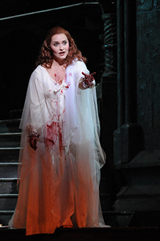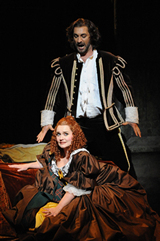| A Lucia to please both eye and ear by Sarah Noble | |
| Donizetti: Lucia di Lammermoor Opera Australia Sydney Opera House 30 July 2008 | |
| Maestro Richard Bonynge conducts with the steady, expert hand to be expected from a man who might just know this opera better than anyone else on the planet. He leads a light, lyrical performance, sensitive always to the needs of his singers. Bonynge's tendency to play it safe might disappoint some - this is a reading as comfortable as the production, relatively free of drastic dynamic extremes or risky innovation - but his bel canto credentials are beyond reproach. Exciting or otherwise, there's no doubting the authenticity of his approach; and if, after several hundred Lucias, he occasionally seems a little blasé in his approach, that's surely understandable. Soprano Emma Matthews, an established darling of Australian audiences, makes a keenly anticipated début in the title role. She could hardly ask for better conditions: a supportive conductor, a theatre packed with adoring fans and music to which her rare agility and pearly tone are ideally suited. Matthews' is a small Lucia, perfectly formed - what she lacks in sheer volume is amply compensated by exquisite, note-perfect singing. Dramatically, she's yet to make the role her own. She clearly revels in the loony antics of the mad scene, but seems unsure of how to portray Lucia's journey to that climactic scene - thus, by the time her Lucia appears, bloodstained and bedraggled, she's done little more than pout dejectedly. But this is not a production dependent upon theatrical credibility; the considerable vocal success which Matthews scores in the role is enough to carry the show. | |
|
The principal trio is backed up by a supporting cast of company stalwarts. Rosemary Gunn's Alisa is a stern duenna, sincerely sung if rather threadbare. Richard Anderson sings with solemnity and careful control as Lucia's tutor, Raimondo, while Graeme Macfarlane is a strong Normanno. Most distinctive is Kanen Breen, clear-voiced and blindingly effete as Arturo, Lucia's bridegroom/victim. The Opera Australia chorus is in strong, unified voice. Copley's staging doesn't require them to do much more than stand around looking concerned, but this they do with aplomb; the unintentionally hilarious Highland dancing at Lucia's wedding is wisely left to the professionals. Resplendent frocks, a handsome set, fabulous singing and just enough blood to keep things interesting - it all adds up to a solid, traditional and enjoyable Lucia, unlikely to devastate, but guaranteed to please both eye and ear. | |
| Text © Sarah Noble Photos © Branco Gaica |
 Swords, tartan and leg-of-mutton sleeves abound in John Copley's production of Donizetti's Lucia di Lammermoor for Opera Australia. At twenty-eight years of age, it's one of the oldest productions still in repertory, but it's also something of a classic. Michael Stennett's opulent period costumes and Henry Bardon's imposing architectural features set the scene for a night of good, old-fashioned bel canto - short on drama, but with plenty of heart and enough beautiful singing to gladden the most jaded heart.
Swords, tartan and leg-of-mutton sleeves abound in John Copley's production of Donizetti's Lucia di Lammermoor for Opera Australia. At twenty-eight years of age, it's one of the oldest productions still in repertory, but it's also something of a classic. Michael Stennett's opulent period costumes and Henry Bardon's imposing architectural features set the scene for a night of good, old-fashioned bel canto - short on drama, but with plenty of heart and enough beautiful singing to gladden the most jaded heart.  Eric Cutler is a remarkably tender and sweet-toned Edgardo, more lover than fighter, despite his sword-brandishing heroics. His bright and beautiful sound blends wonderfully with Matthews' crystalline Lucia in their Act I duet; his "Tombe degli avi miei" is even more impressive, displaying intelligent phrasing, melting legato and a stunningly controlled upper register. José Carbo is similarly excellent as the other man in Lucia's life, her scheming brother Enrico. Carbo's vivid stage presence brings a dash of individuality to this melodramatic role, making him a cruel but charismatic villain. His rich, muscular baritone is consistently thrilling; the duet with Edgardo in the Wolf's Crag scene is particularly electrifying.
Eric Cutler is a remarkably tender and sweet-toned Edgardo, more lover than fighter, despite his sword-brandishing heroics. His bright and beautiful sound blends wonderfully with Matthews' crystalline Lucia in their Act I duet; his "Tombe degli avi miei" is even more impressive, displaying intelligent phrasing, melting legato and a stunningly controlled upper register. José Carbo is similarly excellent as the other man in Lucia's life, her scheming brother Enrico. Carbo's vivid stage presence brings a dash of individuality to this melodramatic role, making him a cruel but charismatic villain. His rich, muscular baritone is consistently thrilling; the duet with Edgardo in the Wolf's Crag scene is particularly electrifying.